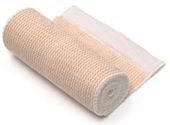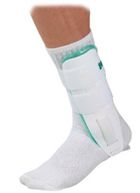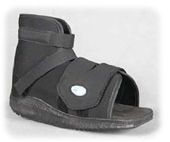A sprained ankle or wrist is no small matter. Sprains occur when the ligament, the tissue that connects your muscle to your bone, has been torn or stretched beyond its normal limits.
They occur in a number of different ways, including falling and twisting. A sprain can be extremely painful and can make it difficult for you to live your normal life until it is appropriately healed. You can improve the healing time of your sprain with a number of techniques, such as keeping the area immobilized, preventing re-injury and help to treat the swelling.
Treating Minor Sprains
 Minor sprains are unlikely to require a trip to the doctor and can be effectively treated by wrapping the area with elastic bandages. Alternating cold and heat and taking anti-inflammatories will help to prevent swelling and decrease the pain. Bandages are cheap, typically less than $10, and can be purchased at a grocery store, pharmacy or sporting goods store. If you are unsure how to properly bandage the area, ask a knowledgeable friend or medical professional to help you.
Minor sprains are unlikely to require a trip to the doctor and can be effectively treated by wrapping the area with elastic bandages. Alternating cold and heat and taking anti-inflammatories will help to prevent swelling and decrease the pain. Bandages are cheap, typically less than $10, and can be purchased at a grocery store, pharmacy or sporting goods store. If you are unsure how to properly bandage the area, ask a knowledgeable friend or medical professional to help you.
Recommended Equipment For Sprains
- Self Adhering Bandages – These bandages will stick to themselves as you roll it around your injured area. No need for tape, clips or Velcro.
- Elastic Bandages – More affordable option that comes with a strong Velcro closure. Great for compression or restricting movement of injured area.
 Adult Boot Casts – Works great as a bumper for someone in a cast. Simple to adjust straps that make taking them off and putting them on very easy.
Adult Boot Casts – Works great as a bumper for someone in a cast. Simple to adjust straps that make taking them off and putting them on very easy.- Walking Boot Casts – Helps reduce swelling by using an air compression system.
If you felt a pop or a tear at the moment of your injury, you should have your sprain checked out by a doctor. An x-ray may be necessary to check the extent of the injury and to make sure that no bones are broken. If you sprained your ankle or another part of your foot, you may be prescribed a device to keep the area immobilized during the healing process. Boot casts are often used to protect sprains, and you may even need to use crutches until your sprain has healed.
 Your doctor may also recommend that you use cold gel braces to treat your sprain. This type of brace is composed of a rigid plastic shell and adjustable straps and heel supports. The brace provides space for a removable cold pack, which provides soothing cold therapy to decrease swelling and bruising and promote healing. Cold gel braces typically cost around $30.
Your doctor may also recommend that you use cold gel braces to treat your sprain. This type of brace is composed of a rigid plastic shell and adjustable straps and heel supports. The brace provides space for a removable cold pack, which provides soothing cold therapy to decrease swelling and bruising and promote healing. Cold gel braces typically cost around $30.
 To prevent re-injury, it’s important to follow your doctor’s instructions and keep the sprained area rested and immobilized. Walking on a sprained ankle or lifting items with a sprained wrist will only cause more damage to the ligament and increase your healing time. If you are careful and follow your doctor’s instructions, your sprain should heal quickly, depending on the severity of the injury, and you will be able to return to your normal lifestyle.
To prevent re-injury, it’s important to follow your doctor’s instructions and keep the sprained area rested and immobilized. Walking on a sprained ankle or lifting items with a sprained wrist will only cause more damage to the ligament and increase your healing time. If you are careful and follow your doctor’s instructions, your sprain should heal quickly, depending on the severity of the injury, and you will be able to return to your normal lifestyle.
